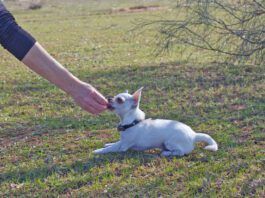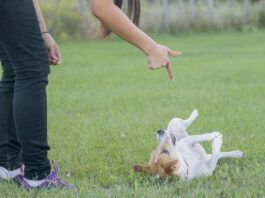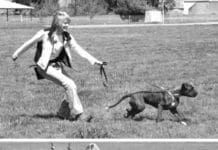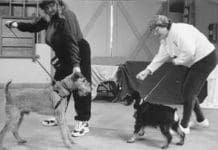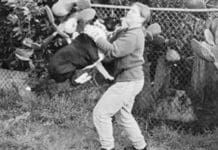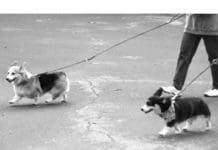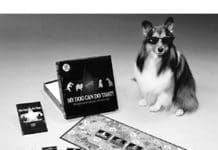Teach Your Dog to Focus On Cue!
Teaching your dog to focus on you (on cue!) is a vitally useful skill – and not that difficult if you follow our step-by-step directions.
Canine Athletic Competition and Sports Psychology
Whether you and your dog are road-seasoned competitors in canine sports, just playing around" in novice dog shows
Canine Class for Aggressive and Problematic Dogs
the focus is on gradually teaching dogs new and more appropriate responses to increasingly proximate contact with other dogs. Pupils begin learning new skills behind visual barriers
Reinforcing Our Beliefs of Positive Dog Training
Regular readers of WDJ are aware that we advocate a positive approach to dog training, that is, using only dog-friendly methods to teach our canine companions how we want them to behave in our homes, our cars, our arms – our world. We eschew methods that hurt or frighten dogs, even in the name of the supposed “greater good.” We think there are plenty of dog-related examples to justify this stance, but occasionally, we also find it useful to look beyond the dog-training profession for reinforcement for our beliefs.
Playing With Your Dog Increases Socialization and Relationships
Different dogs have different play styles. If I tried to play patty-paws with our Australian Kelpie, she would slink away in horror. Her idea of a rousing good time is to help me bring the horses in for their evening grain. Our Cattle Dog mix, Tucker, would rather fetch a stick or a tennis ball, or go jump in the neighbor's pond. Our Scottish Terrier's response to the paws activity would be a bored Whatever . . . " but he'd be delighted to engage in a game of "Let's roust critters out of the drainage pipe!" "
Causes of Reactive Dog Behavior and How to Train A Reactive Dog
“Reactive” is a term gaining popularity in dog training circles – but what is it, exactly? In her book Clinical Behavioral Medicine for Small Animals, Applied Animal Behaviorist Karen Overall, M.A., V.M.D., Ph.D., uses the term to describe animals who respond to normal stimuli with an abnormal (higher-than-normal) level of intensity. Take a deep breath and relax. We have positive training solutions for dogs who "go off" or "lose it" in certain circumstances.
Some Great Leash-Walking Products
The best leash-walking products are effective in helping the owner train the dog not to pull (that is, they provide a large enough window of opportunity for the owner to successfully train the desired walking behavior), minimally aversive to the dog, easy to use, well-made, and affordable. (We put price last, since most owners of leash-pulling dogs would pay almost anything for a product that really helps them!)
Holistic Dog Care and Holistic Checkups for Athletic Dogs
It goes without saying that every dog should undergo an annual health examination, complete with laboratory tests to evaluate blood chemistry and composition. Hard-working dogs – whether they are athletes or used for emotional therapy work – should be taken to the veterinarian for additional exams if their performance or attitude sours. In addition to conventional veterinary examination tehcniques, Dr. Bessent employs an age-old practice, taken from traditional Chinese medicine: tongue and pulse examination of the dog.
Training the Hearing Impaired Dog
hearing and deaf. Using a treat in your hand
Why Force-Based Training Methods Are Not Advocated
or because she's not sure what you want her to do; either way
Training Advice
What to do when spouses disagree about the dog, big dogs get more and more aggressive on walks, and two dogs can’t live together peacefully.
Keeping Dog Training Fun for You and Your Dog
Training works best when it’s enjoyable for you and your dog. Here are training games you can play alone with your dog, or with a group of fun-loving dog friends. While basic good manners and other more complex lessons are undeniably an important part of training, the most successful dog/owner teams are those who have cultivated their relationships with each other while they learn the ins and outs of “Sit,” Down,” “Stay,” and all the other things a dog needs to know.



